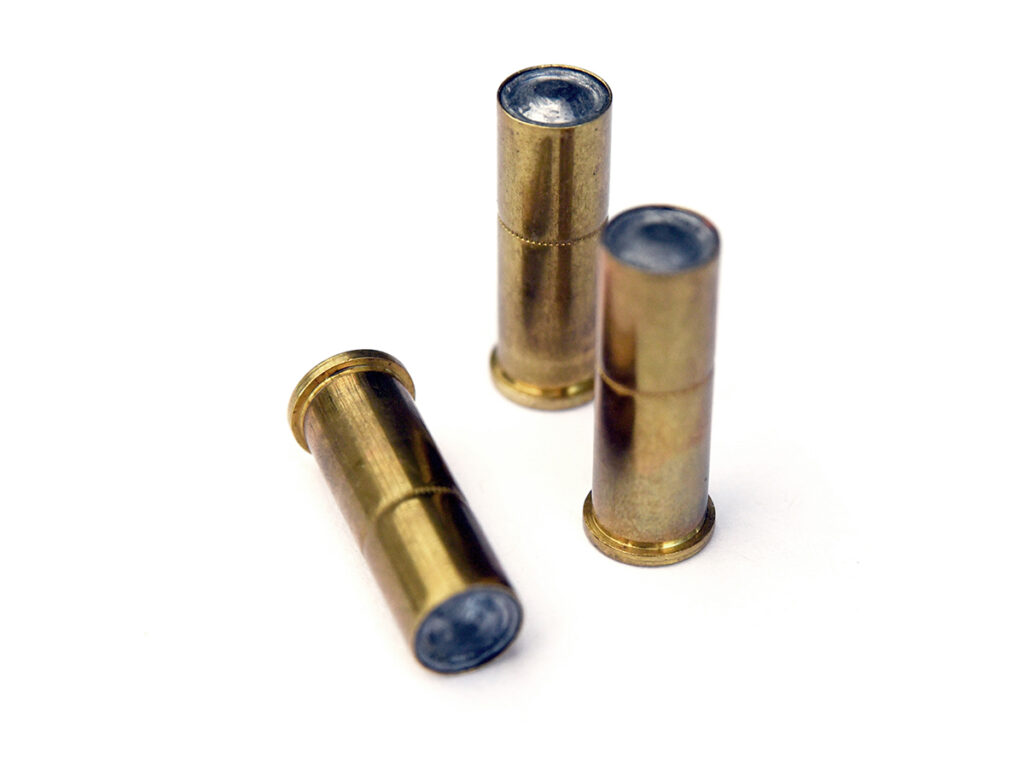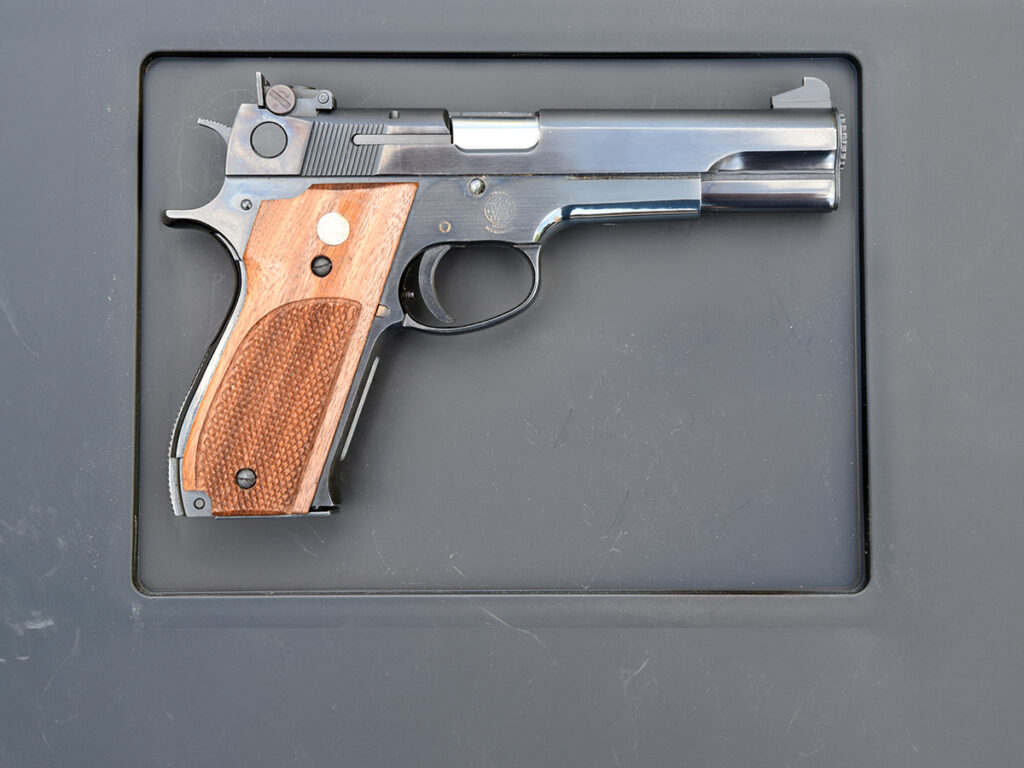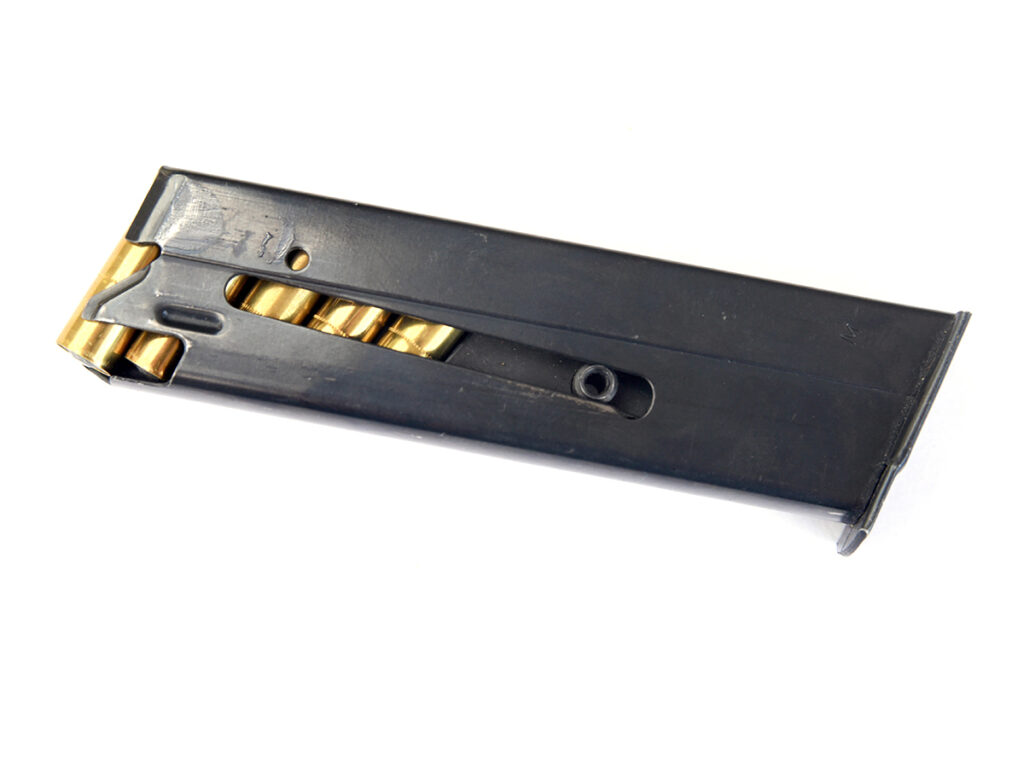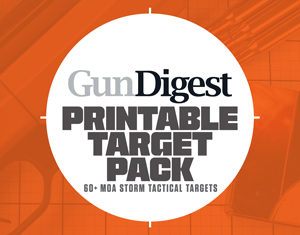
A look back on the Smith & Wesson Model 52, a classic dedicated target pistol in .38 Special.
Sometime back in the early 1990s, my shooting mentor and boss at Ranger Ammunition, Rob Virkus, introduced me to what may still very well be my most favored target pistol of all time: the Smith & Wesson Model 52-2.
Rob and I used to shoot weekly at the Tampa Police Range after delivering their orders of several thousand rounds of ammo. I always had either my 1911s or Magnum revolvers with me, because I was young and poor, but Rob was a master-class shooter of anything with a trigger … and 20 years my senior. He always had something special in his range bag that would get me further into the world of shooting and reloading.
One weekend he showed me what looked like a long-barreled S&W Model 39 with walnut grips and amazing target sights.
“Oh, is that another 9mm?” I said and chuckled.
“No, this is a pistol that will change your life. It’s a 38 Wadcutter,” he said.
“Like a Desert Eagle?” I asked. At the time, I was thinking, rimmed cartridges in a semi-auto with the more familiar semi-wadcutter rounds I’d shoot in my .357.
This time Rob laughed at me and said, “Not exactly.”
He showed me the ammunition, which at first glance looked like empty cases, but were 148-grain hollow-based wadcutters, seated flush with the mouth of the case and a crimp so light that you could almost see space between the bullet and the case walls. Loaded with 2.8 grains of Bullseye, the muzzle velocity was about 735 fps.

The trigger on this pistol was pure excellence. It simply broke like a glass rod with about 2.5 pounds of pressure. The sights are highly visible and minutely adjustable, and after shooting it for 30 minutes or so, I was printing one-hole groups at 30 yards and wondering out loud, “What if you upped this to a +P? It would be the perfect home-defense load. SWAT guys could use it as an entry gun and …”
“Whoa! I’m gonna stop you right there, partner,” said Rob, as he brought me back to reality. “You must load them so there’s just enough energy to throw that slide back and then chamber the next round. This isn’t a fighting pistol like your 1911. This is a target pistol for Bullseye matches and as a training aid to build confidence in new shooters learning how to shoot a semi-auto.”
I was thinking that all I had to do was call Smith & Wesson, or one of the distributors, and order one. Um, no. Unfortunately for me, this story took place in the spring of 1993—and although they had just gotten more expensive because a year earlier, the 30-year-old machinery used to produce the Model 52 was showing signs of age and was starting to fail—Smith & Wesson decided against replacing it, and the handgun was discontinued.
Regardless, I knew I had to have one. I have been lucky enough to own two, but it was a long, hard road.

Smith & Wesson Model 52 Specs
Caliber: .38 Special (Midrange Wadcutter)
Action: Single Action Only (SAO)
Finish: Blue
Stocks: Walnut
Magazine Capacity: 5
Barrel Length: 5 Inches
Slide Length: 8.5 Inches
Weight: 40 Ounces
History of the Model 52
Smith & Wesson introduced the Model 52 as a match-grade target pistol based on the company’s popular 9mm, the Model 39. It was chambered in .38 Special high-brass wadcutter (HBWC) only for the sport of Centerfire Bullseye shooting.
The original Model 52 used the same trigger mechanism of the Model 39, with the double-action function selectable via a simple frame-mounted setscrew, allowing the pistol to be fired in either single-action only or in double-action mode, depending on how you adjusted the screw.
Two years later, in 1963, S&W released the Model 52-1 with a newly developed single-action trigger and manufactured this model until 1970, when it was replaced by the Model 52-2. This version sported an improved extractor and may have been the perfect version of this now iconic pistol. As previously mentioned, within 30 years it’d enter the history books as an out-of-production pistol.

The Finer Points
The S&W Model 52 is a standard semi-automatic pistol not unlike the 1911, Browning Hi Power and S&W’s pre-plastic-framed pistols like the Sigma or M&P series. As stated, it’s a specialized target pistol made for Centerfire Bullseye competitions. The sport doesn’t get much publicity lately, but in its heyday, custom 1911s and specialized semi-autos like the Model 52 dominated.
The finish is a classic, high-polished blue, like many S&W pistols came from the factory for decades. The top strap has a matte finish to reduce glare, and the sights are highly visible with a tall front blade and a micro adjustable rear. It’s not uncommon for shooters to blacken them with a smudge pot or carbide lamp in order to obtain a crisp sight picture.

The slide-mounted safety blocks the firing pin, but it allows a full trigger press. This ensures that the shooter can dry-fire without striking the firing pin and not needing the use of snap caps or dummy rounds. As was common with Smith & Wesson semi-auto pistols, there’s a magazine disconnect that’ll prevent firing when the magazine is removed.
Factory grips were checkered walnut, but some shooters would switch them with S&W Model 39 Pachmayr grips. Its barrel bushing is adjustable, but admittedly, the bushing isn’t the greatest in the world, and a special wrench is needed to adjust it. If you’re looking to buy a Model 52, make sure this wrench is included: They’re not that hard to find, nor that expensive, but it shows the owner took care of the pistol.
The only other factory accessory was a weight that could be attached to the bottom of the dustcover by means of a set screw. Original factory weights are marked “S&W,” but aftermarket weights were not. Spare magazines are north of $125 … when you can find them.

This One is Mine
As a young veteran making ammunition for a living, I didn’t have a whole lot of spending money to buy any gun I wanted. I would comb pawn shops and gun shops looking for deals in the days before the internet … when you still could score things at a great price. I found an original Model 52 (no dash), and while it might not have been a classic like Rob’s, I loved it.
Unfortunately, a calamity struck my life a few years later where I had to sell off the bulk of my small collection and move to an area with better job opportunities. In the midst of the Draconian Clinton Assault Weapon Ban, certain guns that I thought could be easily replaced, like my beloved Model 52, had to go. As I passed it off to a collector who paid me more than what I paid for it, I vowed I would get another.
A few years went by and I was more focused on rebuilding my life and family than rebuilding my lost collection, but by 2001, I was doing better than I ever had with a great job and had the funds to purchase a Model 52. The only problem was, I was now in California and “the roster” had just been put in place.
For those of you in Free America, that year California decided to impose strict regulations regarding the sale and transfer of handguns. If a handgun wasn’t listed on the roster, it could only be purchased from another individual through an FFL. It might’ve been easier a few years later when they allowed an exemption for Olympic target pistols, but at that time, there was no exemption. That meant, the seller and I would have to meet at a gun shop and perform the transfer in person.
After 8 months of searching and having people trying to find me a Model 52, one turned up, and—most importantly—the dealer was willing to broker the transaction and the price was decent. The problem was he was in Southern California, and I was in the north about 500 miles away. On top of that, California has a 10-day waiting period, meaning I had to drive 1,000 miles round trip to buy it, then 10 days later repeat the process to pick it up. Once it was in my possession, it was a constant range companion for years.

A Picky Eater
Making your own ammunition is the best way to go on these, as accuracy for each pistol tends to be load dependent. At one time, I found this pistol cheaper to shoot than .22 LR. It uses very little powder and a cheap, soft lead swaged bullet. Swaged bullets are typically better for this pistol than cast. You might find a local commercial loader offering plated or jacketed bullets, but they generally don’t fare well in the Model 52. The plated bullets can work with the right load data, but the jacketed bullets have never performed well for me.
The trigger breaks at 1.74 pounds, and with my ammunition, I guarantee any student who fires it that they will hit the 9 ring at 25 yards with one hand if they have their basic fundamentals down.
Even though it has no practical purpose for hunting, home defense, 3-gun or any “real world use,” it’ll most likely be the last pistol that ever leaves my collection. It’s an accurate and reliable shooter. It excels at everything you could want in a dedicated target pistol: punching holes in paper.
Editor's Note: This article originally appeared in the October 2024 issue of Gun Digest the Magazine.
More Classic Guns:
- Ten Classic Guns You've Got To Own
- High Standard .22 Pistols
- Collecting The Colt Single Action Army
- The Colt Model 1903 Pocket Pistol
- A History Of The 1911

Next Step: Get your FREE Printable Target Pack
Enhance your shooting precision with our 62 MOA Targets, perfect for rifles and handguns. Crafted in collaboration with Storm Tactical for accuracy and versatility.
Subscribe to the Gun Digest email newsletter and get your downloadable target pack sent straight to your inbox. Stay updated with the latest firearms info in the industry.

![Best Concealed Carry Guns In 2025 [Field Tested] Wilson Combat EDC X9S 1](https://gundigest.com/wp-content/uploads/Wilson-Combat-EDC-X9S-1-324x160.jpg)


![Best 9mm Carbine: Affordable PCCs [Tested] Ruger Carbine Shooting](https://gundigest.com/wp-content/uploads/Ruger-Carbine-Shooting-100x70.jpg)
![Best AR-15: Top Options Available Today [Field Tested] Harrington and Richardson PSA XM177E2 feature](https://gundigest.com/wp-content/uploads/Harrington-and-Richardson-PSA-XM177E2-feature-100x70.jpg)
